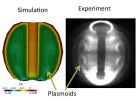Microgravity experiments may help lighten the load of joint diseases
New research in the FASEB Journal suggests that cartilage cells remain relatively protected from the stress of microgravity by up-regulation of BMP-2 gene and protein expression
2015-06-01
(Press-News.org) Going into space might wreak havoc on our bodies, but a new set of microgravity experiments may help shed light on new approaches for treating cartilage diseases on Earth. In a new research report published in the June 2015 issue of The FASEB Journal, a team of European scientists suggests that our cartilage--tissue that serves as a cushion between bones--might be able to survive microgravity relatively unscathed. Specifically, when in a microgravity environment, chondrocytes (a main component of cartilage) were more stable and showed only moderate alterations in shape and structure when compared to their Earthbound counterparts. This was particularly the case for those also exposed to growth factors and specific nutrients. For those of us on the ground, the success of the growth factors and nutrients suggests that it might be possible to halt cartilage degradation or even reverse it with improved nutrition and/or new drugs.
"Research under microgravity helps us in many ways to understand the complex processes of life and as an excellent example of the gravity-dependent mechanisms that underlie cartilage diseases," said Daniela Gabriele Grimm, M.D., a researcher involved in the work from the Department of Biomedicine, Pharmacology at Aarhus University in Aarhus, Denmark. "We hope to find new strategies to prevent and to treat cartilage damages not only in astronauts, but also in patients on Earth."
To make this discovery, Grimm and colleagues used three different groups of human chondrocytes for the flight experiment. The first group of chondrocytes was cultured and fixed to preserve the cells in their current state, without further alterations of morphology and metabolism, in the laboratory on the ground. The second and the third groups were cultured on the ground and taken on board an aircraft, which flew a total of 31 parabolas. During each of the parabolas the cells were exposed to a period of weightlessness. While the second group was fixed during the parabolic flight after the first parabola, the third group was fixed after the last parabola. After the flight, the samples from all three groups were collected on the ground in the laboratory and used for analyses.
"As our nation grows both in age and weight, the need to address cartilage breakdown will increase as well," said Gerald Weissmann, M.D., Editor-in-Chief of The FASEB Journal. "This important study suggests a mechanism used by the body to maintain cartilage integrity in the face of microgravitational stress. What works for cartilage in space promises to help us moving on the turf."
INFORMATION:
Receive monthly highlights from The FASEB Journal by e-mail. Sign up at http://www.faseb.org/fjupdate.aspx. The FASEB Journal is published by the Federation of the American Societies for Experimental Biology (FASEB). It is the world's most cited biology journal according to the Institute for Scientific Information and has been recognized by the Special Libraries Association as one of the top 100 most influential biomedical journals of the past century.
FASEB is composed of 27 societies with more than 120,000 members, making it the largest coalition of biomedical research associations in the United States. Our mission is to advance health and welfare by promoting progress and education in biological and biomedical sciences through service to our member societies and collaborative advocacy.
Details: Ganna Aleshcheva, Markus Wehland, Jayashree Sahana, Johann Bauer, Thomas J. Corydon, Ruth Hemmersbach, Timo Frett, Marcel Egli, Manfred Infanger, Jirka Grosse, and Daniela Grimm. Moderate alterations of the cytoskeleton in human chondrocytes after short-term microgravity produced by parabolic flight maneuvers could be prevented by up-regulation of BMP-2 and SOX-9. FASEB J. June 2015 29:2303-2314; doi:10.1096/fj.14-268151 ; http://www.fasebj.org/content/29/6/2303.abstract
ELSE PRESS RELEASES FROM THIS DATE:
2015-06-01
There's an urgent demand for new antimicrobial compounds that are effective against constantly emerging drug-resistant bacteria. Two robotic chemical-synthesizing machines, named Symphony X and Overture, have joined the search. Their specialty is creating custom nanoscale structures that mimic nature's proven designs. They're also fast, able to assemble dozens of compounds at a time.
The machines are located in a laboratory on the fifth floor of the Molecular Foundry, a DOE Office of Science User Facility at Berkeley Lab. They make peptoids, which are synthetic versions ...
2015-06-01
GAINESVILLE, Fla. -- If a picture is worth a thousand words, UF Health Type 1 diabetes researchers and their colleagues have tapped into an encyclopedia, revealing new insights into how young people cope with the disease.
The sophisticated scientific instrument? A camera.
More than 13,000 children and teens are diagnosed with Type 1 diabetes each year. To find out more about their experiences as they live with this chronic disorder, a group of diabetes researchers from three universities, including the University of Florida, gave 40 adolescents disposable cameras and ...
2015-06-01
People with achromatopsia, an inherited eye disorder, see the world literally in black and white. Worse yet, their extreme sensitivity to light makes them nearly blind in bright sunlight. Now, researchers at University of California, San Diego School of Medicine and Shiley Eye Institute at UC San Diego Health System have identified a previously unknown gene mutation that underlies this disorder.
The study published online June 1 in the journal Nature Genetics.
"There are whole families with this sort of vision problem all over the world," said Jonathan Lin, MD, ...
2015-06-01
Researchers at the U.S. Department of Energy's Princeton Plasma Physics Laboratory (PPPL) have for the first time simulated the formation of structures called "plasmoids" during Coaxial Helicity Injection (CHI), a process that could simplify the design of fusion facilities known as tokamaks. The findings, reported in the journal Physical Review Letters, involve the formation of plasmoids in the hot, charged plasma gas that fuels fusion reactions. These round structures carry current that could eliminate the need for solenoids - large magnetic coils that wind down the center ...
2015-06-01
There is a wealth of published information describing interactions between drugs used to treat cardiovascular disease and the genetic variations that can affect how patients respond to them. But few heart specialists make routine use of this potentially life-saving data.
To help physicians make better-informed clinical decisions, researchers from the University of Chicago and Stanford University combed through scientific literature on the pharmacogenomics of 71 leading cardiovascular drugs and compiled summaries, published in the June issue of the Mayo Clinic Proceedings.
"Tens ...
2015-06-01
Academic programs that provide alternatives to traditional remedial education help students succeed at community colleges, but different programs result in a range of outcomes for various sub-populations of students. Drew Allen, a New York University doctoral student and director of the Office of Research, Evaluation, and Program Support at the City University of New York (CUNY), devoted his doctoral research to the evaluation of three current programmatic approaches at CUNY community colleges.
Entering community college students are often required to take remedial, ...
2015-06-01
Some female members of a critically endangered species of sawfish are reproducing in the wild without sex. The discovery, reported in the Cell Press journal Current Biology on June 1, marks the first time living offspring from "virgin births" have been found in a normally sexually reproducing vertebrate in the wild, the researchers say.
Earlier evidence that vertebrates might sometimes reproduce via a process called parthenogenesis had primarily come from isolated examples of captive animals--including birds, reptiles, and sharks. In those instances, the animals in question ...
2015-06-01
Despite guideline recommendations to limit medical tests before low-risk surgeries, electrocardiograms (ECGs) and chest x-rays are still performed frequently, found a study in CMAJ (Canadian Medical Association Journal).
Evidence indicates that for patients undergoing low-risk surgery, routine testing does not improve outcomes and can actually lead to surgical delays, patient anxiety and other issues. The Choosing Wisely campaign, which started in the United States and spread to Canada and other countries, aims to raise awareness of unnecessary tests and procedures among ...
2015-06-01
Radon gas is a silent health threat, and Canada needs to align its guidelines for acceptable radon levels with World Health Organization (WHO) limits, argues an editorial in CMAJ (Canadian Medical Association Journal).
"We are left in an odd situation in Canada," writes Dr. Diane Kelsall, Deputy Editor, CMAJ. "Drivers and passengers are required to wear seat belts, which are estimated to save about 1000 lives per year. Smoke alarms are required in most jurisdictions, reducing the annual rate of fire-related deaths from 130 per million households by about two-thirds. Yet, ...
2015-06-01
ROSEMONT, Ill.--Woman in general have a higher incidence of osteoporosis-related hip fractures yet, conversely, they have a lower rate of mortality than men with the same fracture, according to a study in the June 2015 issue of the Journal of the American Academy of Orthopaedic Surgeons (JAAOS). In addition, doctors don't always recognize or treat osteoporosis in men as often as they do in women.
"Male and Female Differences Matter in Musculoskeletal Disease" details the differences between how common musculoskeletal disorders manifest themselves in males versus females. ...
LAST 30 PRESS RELEASES:
[Press-News.org] Microgravity experiments may help lighten the load of joint diseases
New research in the FASEB Journal suggests that cartilage cells remain relatively protected from the stress of microgravity by up-regulation of BMP-2 gene and protein expression

